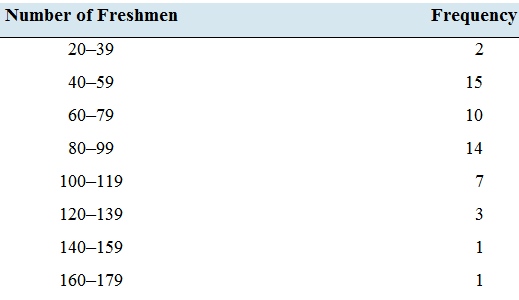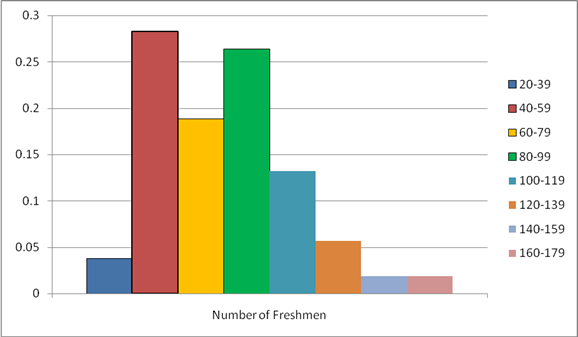
House freshmen: Newly elected members of the U.S. House of Representatives are referred to as “freshmen.” The following frequency distribution presents the number of freshmen elected in each of the past 53 elections, from 1912 to 2016.

- How many classes are there?
- What is the class width?
- What are the class limits?
- Construct a frequency histogram.
- Construct a relative frequency distribution.
- Construct a relative frequency histogram.
- In what percentage of elections were loo or more freshmen elected?
- In what percentage of elections were fewer than 60 freshmen elected?
a.
To find:Number of classes.
Answer to Problem 6RE
The number of classes is 8.
Explanation of Solution
Given information:The following frequency distribution presents the numberof freshmen elected in each of the past 53 elections from 1912 to 2016.
| Number of Freshmen | Frequency |
| 20-39 | 2 |
| 40-59 | 15 |
| 60-79 | 10 |
| 80-99 | 14 |
| 100-119 | 7 |
| 120-139 | 3 |
| 140-159 | 1 |
| 160-179 | 1 |
Calculation:
The classes from the given table are 20-39, 40-59, 60-79, 80-99, 100-119, 120-139, 140-159 and 160-179.
There are eight classes are there.
Hence, the number of classes is 8.
b.
To find: The class width.
Answer to Problem 6RE
The class width is 19.
Explanation of Solution
Given information: The following frequency distribution presents the number of freshmen elected in each of the past 53 elections from 1912 to 2016.
| Number of Freshmen | Frequency |
| 20-39 | 2 |
| 40-59 | 15 |
| 60-79 | 10 |
| 80-99 | 14 |
| 100-119 | 7 |
| 120-139 | 3 |
| 140-159 | 1 |
| 160-179 | 1 |
Formula used:
Calculation:
From the given table, the largest value is 179 and the smallest value is 20.
The number of classes is 8.
Then the class width is given by
Hence, the class width is 19.
c.
To find: The class limits.
Answer to Problem 6RE
The lower class limits are 20, 40, 60, 80, 100, 120, 140 and 160.
The upper class limits are 39, 59, 79, 99, 119, 139, 159 and 179.
Explanation of Solution
Given information: The following frequency distribution presents the number of freshmen elected in each of the past 53 elections from 1912 to 2016.
| Number of Freshmen | Frequency |
| 20-39 | 2 |
| 40-59 | 15 |
| 60-79 | 10 |
| 80-99 | 14 |
| 100-119 | 7 |
| 120-139 | 3 |
| 140-159 | 1 |
| 160-179 | 1 |
Definition used:
The lower class limits of a class are the smallest value that can appear in that class.
The upper class limits of a class are the largest value that can appear in that class.
Calculation:
From the given table we can say that
The lower class limits are 20, 40, 60, 80, 100, 120, 140 and 160.
The upper class limits are 39,59, 79, 99, 119, 139, 159 and 179.
d.
To construct: A frequency histogram.
Explanation of Solution
Given information: The following frequency distribution presents the number of freshmen elected in each of the past 53 elections from 1912 to 2016.
| Number of Freshmen | Frequency |
| 20-39 | 2 |
| 40-59 | 15 |
| 60-79 | 10 |
| 80-99 | 14 |
| 100-119 | 7 |
| 120-139 | 3 |
| 140-159 | 1 |
| 160-179 | 1 |
Definition used:
Histogram based on frequency is called frequency histogram.
Solution:
From the given table, the frequency histogram is given by

e.
To construct: The relative frequency distribution.
Explanation of Solution
Given information: The following frequency distribution presents the number of freshmen elected in each of the past 53 elections from 1912 to 2016.
| Number of Freshmen | Frequency |
| 20-39 | 2 |
| 40-59 | 15 |
| 60-79 | 10 |
| 80-99 | 14 |
| 100-119 | 7 |
| 120-139 | 3 |
| 140-159 | 1 |
| 160-179 | 1 |
Formula used:
Calculation:
From the given table,
The sum of all frequency is
The table of relative frequency is given by
| Number of Freshmen | Frequency | Relative Frequency |
| 20-39 | 2 | |
| 40-59 | 15 | |
| 60-79 | 10 | |
| 80-99 | 14 | |
| 100-119 | 7 | |
| 120-139 | 3 | |
| 140-159 | 1 | |
| 160-179 | 1 |
f.
To construct: A relative frequency histogram.
Explanation of Solution
Given information: The following frequency distribution presents the number of freshmen elected in each of the past 53 elections from 1912 to 2016.
| Number of Freshmen | Frequency |
| 20-39 | 2 |
| 40-59 | 15 |
| 60-79 | 10 |
| 80-99 | 14 |
| 100-119 | 7 |
| 120-139 | 3 |
| 140-159 | 1 |
| 160-179 | 1 |
Definition used:
Histogram based on relative frequency is called relative frequency histogram.
Solution:
| Number of Freshmen | Frequency | Relative Frequency |
| 20-39 | 2 | |
| 40-59 | 15 | |
| 60-79 | 10 | |
| 80-99 | 14 | |
| 100-119 | 7 | |
| 120-139 | 3 | |
| 140-159 | 1 | |
| 160-179 | 1 |
From the above table, the relative frequency histogram is given by

g.
To find: The percentage of elections was 100 or more freshmen elected.
Answer to Problem 6RE
The percentage of elections was 100 or more freshmen elected is
Explanation of Solution
Given information: The following frequency distribution presents the number of freshmen elected in each of the past 53 elections from 1912 to 2016.
| Number of Freshmen | Frequency |
| 20-39 | 2 |
| 40-59 | 15 |
| 60-79 | 10 |
| 80-99 | 14 |
| 100-119 | 7 |
| 120-139 | 3 |
| 140-159 | 1 |
| 160-179 | 1 |
Definition used:
Percentage for a frequency is given by
Calculation:
From the given table we can say that
The frequency for 100 or more freshmen elected is 7, 3, 1 and 1.
The sum of all frequencies of 100 or more freshmen were elected is
The sum of all frequency is 53.
Hence, the percentage is given by
Hence, the percentage of elections was 100 or more freshmen electedis
h.
To find: The percentage of elections was fewer than 60 freshmen elected.
Answer to Problem 6RE
Thepercentage of elections was fewer than 60 freshmen elected is
Explanation of Solution
Given information: The following frequency distribution presents the number of freshmen elected in each of the past 53 elections from 1912 to 2016.
| Number of Freshmen | Frequency |
| 20-39 | 2 |
| 40-59 | 15 |
| 60-79 | 10 |
| 80-99 | 14 |
| 100-119 | 7 |
| 120-139 | 3 |
| 140-159 | 1 |
| 160-179 | 1 |
Definition used:
Percentage for a frequency is given by
Calculation:
From the given table we can say that
The frequency for fewer than 60 freshmen elected is 2 and 15.
The sum of all frequencies of fewer than 60 freshmen were elected is
The sum of all frequency is 53.
Hence, the percentage is given by
Hence, the percentage of elections was fewer than 60 freshmen elected is
Want to see more full solutions like this?
Chapter 2 Solutions
ELEMENTARY STATISTICS LOOSE+ACCESS COD
 Glencoe Algebra 1, Student Edition, 9780079039897...AlgebraISBN:9780079039897Author:CarterPublisher:McGraw Hill
Glencoe Algebra 1, Student Edition, 9780079039897...AlgebraISBN:9780079039897Author:CarterPublisher:McGraw Hill
